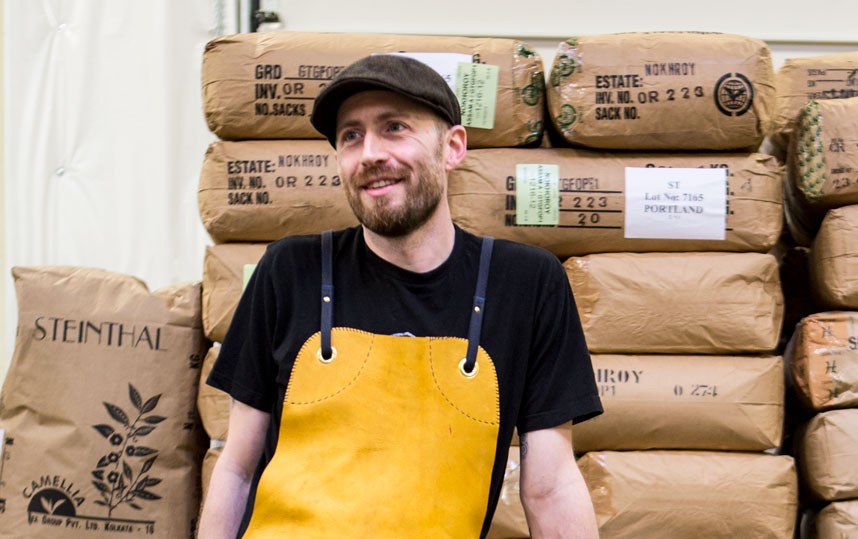[O]n a recent visit to Steven Smith Teamaker’s new headquarters in southeast Portland I sat down with head teamaker Tony Tellin to talk about barrel-scented teas. Midway through our chat, one of the tearoom attendants walked in with a latte and a crème brûlée torch. He proceeded to burn the top of the milky drink, caramelizing the brown sugar that sparkled there, while Tellin described what was inside: whole milk, house-made brown sugar sauce, and moringa (an Indian herb) scented in an Irish whiskey barrel with Spanish orange peel, sarsaparilla, star anise, and bourbon vanilla. The Irish Moringa Latte, richly layered and malty, is one of the tearoom’s creation using three unique teas recently “scented” by Tellin and the Smith team using Irish whiskey, aquavit, and rum barrels. After trying these blends—which expertly layer and pair the flavors of alcohols, teas, spices, and herbs—we had to know more about the process behind them.
You started barrel aging in 2009?
Yeah, 2009 or 2010. Whiskey was the first. We’ve always had a lot of friends here in town that were direct distillers or friends of distillers or winemakers and various other barrel users, but I don’t really recall where the idea came from.
So it just turned into experimentation?
It did. We are always trying a lot of things, only a sliver of which ever makes it to the consumer’s eyes. I remember looking for a barrel and it actually being difficult to find a barrel that people wanted to give me. People wanted to sell me barrels. I found a lot of people that had barrels that had no use left in them who wanted to give me those. But to find one in perfect working order that still had flavor and aroma that was beneficial was very difficult. I ended up sending Jack Joyce [cofounder of Rogue Ales] a message saying, “Hey, I really want to barrel-age some teas,” and I never got a response, but a barrel showed up on my doorstep a week later. And not only did I get a barrel, I got two barrels and a steel girder system for holding them in place. It was very generous of Rogue.
How were those first teas?
Good. Still today the reason I like the barrel-scented teas is you don’t quite know what you’re going to get, and at the end of it you’re still rolling the dice. There are some things we do to try and predict how the tea’s going to taste after it’s sat in the barrel for a period of time, but not all aromatics soak up evenly and not all flavor combinations are the sum of the ingredients, right? Sometimes you get this unexpected surprise and sometimes you get this unexpected blooper reel. The first one we did was good; it showed a lot of promise. The second one we did is when we expanded and started selling it by the ounce. That was with a Bull Run Distilling bourbon barrel. Then we started working with Adelsheim Vineyard and putting tea in a pinot noir barrel.
What’s the science behind how this works?
I don’t think we really have this down where I can tell you, “This is the recipe for how this works.” No two teas or two barrels are the same. The amount of the moisture isn’t the same. What I can tell you for sure is it is about gaining moisture, and with the moisture comes aroma and flavor. And at the end of the day we have to dry off of a lot of the moisture we put into the teas. So we can set tea in a barrel for a period of time, and when we find that perfect balance when we taste it and smell it and think it’s right then we’ll go through the drying process and dry all the leaves.
What’s the difference between barrel-aging and barrel-scenting?
I think a lot of people are putting stock on aging, and I don’t see a big enough difference between two months and six months. . . . In the end you have to dry it back down, so the more you pump into it the more you’re going to take out of it. And some of the notes—woodsy, oaky—are a slippery slope to papery, which is usually tea that is old and tired. So I think barrel-aged became old at a certain point.
How do you establish consistency?
This year we did two things differently. Two of our teas had direct contact with the barrel. For the White Chrysmas, we put jasmine blossoms and osmanthus blossoms on the floor of the barrel and then put the tea on top of that, so it didn’t make contact with the barrel itself, because we wanted the white tea to be more prominent than the rum and the pear brandy. But most of the time you put it directly in, and everyday we spin it, basically rotate it inside the barrel so you don’t have patches that are too wet, then when you’re done we pull the tea out, blend it, dry it, taste it to make sure that it’s blended enough, and after that it’s a stable material.
There were months and months of trials. We used mason jars to kind of predict how they would be. We’d take, for example, the aquavit, put a couple of drops in and put the tea in there to try and get a ballpark idea of how the flavors might comingle together. Then we got tea in the barrel, and it was just checking on it every other day, see what we needed to add and see where it went.
—Regan Crisp is a writer based in Portland.









